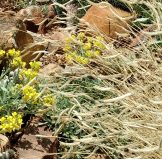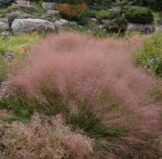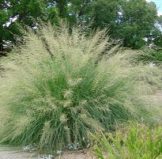
(Photo and description credit: Plant Select.)
Alpine plume grass is a spectacular long-lived grass from high mountain meadows in central and southern Europe. A mature plant makes a dramatic specimen, with several dozen flower heads waving above a graceful fountain of fresh green foliage. The flowers persist from summer until the following spring when the entire plant should be cut back to make room for the new season’s growth. Unlike many other ornamental grasses, the foliage doesn’t die out in the clump’s center over time.

 Native! Big Bluestem is taller and has a wider blade than Little Bluestem and is somewhat upright but also arching. It also has attractive reddish and purple fall colors. Big Bluestem is one of the dominant components of the Tallgrass Prairies across the Great Plains, where it can reach 8’ in height. Here it can range from 2 to 5’ tall, depending on water and nutrients available. In late summer, Big Bluestem’s purplish red flowers appear in groups of three or six, which look like a turkey foot – hence the nickname: “Turkey Foot Grass”. The root system can extend down more than 10 feet. Each year, a third of these roots die, feeding soil microorganisms and opening up channels for water. This plant is drought tolerant once it’s established. Attracts birds and butterfly larvae.
Native! Big Bluestem is taller and has a wider blade than Little Bluestem and is somewhat upright but also arching. It also has attractive reddish and purple fall colors. Big Bluestem is one of the dominant components of the Tallgrass Prairies across the Great Plains, where it can reach 8’ in height. Here it can range from 2 to 5’ tall, depending on water and nutrients available. In late summer, Big Bluestem’s purplish red flowers appear in groups of three or six, which look like a turkey foot – hence the nickname: “Turkey Foot Grass”. The root system can extend down more than 10 feet. Each year, a third of these roots die, feeding soil microorganisms and opening up channels for water. This plant is drought tolerant once it’s established. Attracts birds and butterfly larvae.

 The most popular and over-used ornamental grass, for good reason. Medium sized (to 4’ tall), very erect form, easy to grow and highly adaptable to everything but shade, very durable flower/seed heads remain attractive all summer, fall and winter. No fall foliage color. Cut down in early February. Try to avoid plantings that look like rows of soldiers standing at attention!
The most popular and over-used ornamental grass, for good reason. Medium sized (to 4’ tall), very erect form, easy to grow and highly adaptable to everything but shade, very durable flower/seed heads remain attractive all summer, fall and winter. No fall foliage color. Cut down in early February. Try to avoid plantings that look like rows of soldiers standing at attention! To 3’ or 4’ tall, with a graceful fountain-like or mounded shape, and waits until the end of the summer to flower. Can take some shade. Very pretty, with pinkish plumes that dry tan. No fall color. Plant Select. Should be used more.
To 3’ or 4’ tall, with a graceful fountain-like or mounded shape, and waits until the end of the summer to flower. Can take some shade. Very pretty, with pinkish plumes that dry tan. No fall color. Plant Select. Should be used more. A small fountain-like clumping sedge, 6-10”h x 10-12” w, very fine-textured, bright light green and very attractive. Native to woods in Eastern N. America, it grows well in dry shade or part shade. It mixes well with perennials and serves as a neat groundcover or edger. Its tenacious roots will prevent erosion on shady slopes, and it can grow among tree roots. Very small, attractive blooms occur in spring, supporting beneficial insects.
A small fountain-like clumping sedge, 6-10”h x 10-12” w, very fine-textured, bright light green and very attractive. Native to woods in Eastern N. America, it grows well in dry shade or part shade. It mixes well with perennials and serves as a neat groundcover or edger. Its tenacious roots will prevent erosion on shady slopes, and it can grow among tree roots. Very small, attractive blooms occur in spring, supporting beneficial insects. This petite sedge is rhizomatous and spreads. Its long glossy blades are slightly variegated yellow and green, and curve to the ground, giving it a mop-headed look. Makes an excellent groundcover or small ‘lawn’ (just to look at, not to step on) in shady gardens, especially Asian-styled gardens. Almost evergreen.
This petite sedge is rhizomatous and spreads. Its long glossy blades are slightly variegated yellow and green, and curve to the ground, giving it a mop-headed look. Makes an excellent groundcover or small ‘lawn’ (just to look at, not to step on) in shady gardens, especially Asian-styled gardens. Almost evergreen. A US native, though not native here, this grass grows well in part shade. The wide, bright green blades emerge from the stems at many heights, giving it a slightly bamboo-like look. The pendulous seed clusters in late summer are composed of very attractive flat, plaited spikelets, starting out pale green, later turning tan. Foliage stays green until fall, when it turns yellow. It will self-sow but is not difficult to control.
A US native, though not native here, this grass grows well in part shade. The wide, bright green blades emerge from the stems at many heights, giving it a slightly bamboo-like look. The pendulous seed clusters in late summer are composed of very attractive flat, plaited spikelets, starting out pale green, later turning tan. Foliage stays green until fall, when it turns yellow. It will self-sow but is not difficult to control.
 A much sought-after modest-sized evergreen grass with powder-blue blades, and that has some shade tolerance. It forms an open, symmetrical mound of foliage from 12” to 24” high, and a bit wider, looking like the ‘big brother’ of Blue Fescue. Bloom stalks add another 12 to 18”, and provide interest for several months.
A much sought-after modest-sized evergreen grass with powder-blue blades, and that has some shade tolerance. It forms an open, symmetrical mound of foliage from 12” to 24” high, and a bit wider, looking like the ‘big brother’ of Blue Fescue. Bloom stalks add another 12 to 18”, and provide interest for several months.

 Also known as Ponytail Grass, this small grass, to 14” tall, has very fine-textured blades that make a ‘fountain’ of green. It can sometimes be evergreen. This grass may not be very long-lived, but will replace itself with seedlings, which can be relocated when small.
Also known as Ponytail Grass, this small grass, to 14” tall, has very fine-textured blades that make a ‘fountain’ of green. It can sometimes be evergreen. This grass may not be very long-lived, but will replace itself with seedlings, which can be relocated when small. Historically February is one of Colorado’s snowiest months, and finally we’re beginning to see evidence of that this year! Additionally, the forecast indicates more to come. It remains to be seen how some of our marginally hardy garden plants have suffered from the below zero temperatures.
Historically February is one of Colorado’s snowiest months, and finally we’re beginning to see evidence of that this year! Additionally, the forecast indicates more to come. It remains to be seen how some of our marginally hardy garden plants have suffered from the below zero temperatures.
